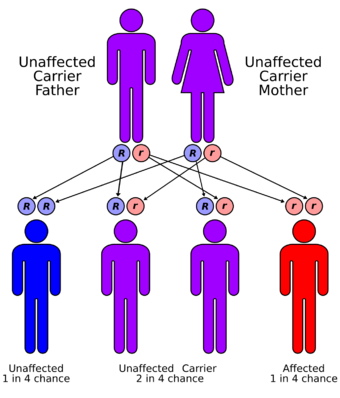Medicine:Multiple sulfatase deficiency
| Multiple sulfatase deficiency | |
|---|---|
| Other names | Juvenile sulfatidosis, Austin type |
 | |
| Multiple sulfatase deficiency is autorecessive | |
Multiple sulfatase deficiency (MSD), also known as Austin disease,[1] or mucosulfatidosis,[1] is a very rare autosomal recessive[2]:561 lysosomal storage disease[3] caused by a deficiency in multiple sulfatase enzymes, or in formylglycine-generating enzyme, which activates sulfatases.[4]:502[5] It is similar to mucopolysaccharidosis.[6]
Signs and symptoms
Symptoms of this disorder commonly appear between one and two years of age. Symptoms include mildly coarsened facial features, deafness, ichthyosis[7] and an enlarged liver and spleen (hepatosplenomegaly).[8] Abnormalities of the skeleton, such as a curving of the spine and breast bone may occur. The skin of individuals afflicted with this disorder, is typically dry.[9] Children affected by this disorder develop more slowly than normal and may display delayed speech and walking skills.[9]
The disease is fatal, with symptoms that include neurological damage and severe mental retardation.[10] These sulfatase enzymes are responsible for breaking down and recycling complex sulfate-containing sugars from lipids and mucopolysaccharides within the lysosome. The accumulation of lipids and mucopolysaccharides inside the lysosome results in symptoms associated with this disorder. (As of 2018), 75–100 cases of MSD had been reported worldwide.[9]
Causes
Multiple sulfatase deficiency is caused by any mutation of the SUMF1 gene which renders its protein product, the formylglycine-generating enzyme (FGE), defective.[11][12] These mutations result in inactive forms of FGE.[13] This enzyme is required for posttranslational modification of a cysteine residue in the sulfatase enzyme active site into formylglycine,[14] which is required for its proper function.[15]
Genetics
MSD has an autosomal recessive inheritance pattern.[2]:561 The inheritance probabilities per birth are as follows:
- If both parents are carriers:
- 25% (1 in 4) children will have the disorder
- 50% (2 in 4) children will be carriers (but unaffected)
- 25% (1 in 4) children will be free of MSD - unaffected child that is not a carrier
- If one parent is affected and one is free of MSD:
- 0% (0) children will have the disorder - only one parent is affected, other parent always gives normal gene
- 100% (4 in 4) children will be carriers (but unaffected)
- If one parent is a carrier and the other is free of MSD:
- 50% (2 in 4) children will be carriers (but unaffected)
- 50% (2 in 4) children will be free of MSD - unaffected child that is not a carrier
Diagnosis
MSD may be diagnosed when deficiency of more than one sulfatase enzyme is identified in leukocytes or fibroblasts,[16] or by molecular genetic testing which shows pathogenic variation in both alleles of the SUMF1 gene.[9]
Treatment
As there is no cure for MSD, treatment is restricted to management of symptoms.[16] There is much research on MSD that is currently underway. MSD Action Foundation have initiated more than 15 research projects on MSD in the last 6 years. Many of these have a translational focus. It is hoped that clinical trials for MSD will happen in the not too distant future- Alan Finglas. [Ref 17. Finglas 2020]
See also
- Linear porokeratosis
- List of cutaneous conditions
References
- ↑ 1.0 1.1 Rapini, Ronald P.; Bolognia, Jean L.; Jorizzo, Joseph L. (2007). Dermatology: 2-Volume Set. St. Louis: Mosby. ISBN 978-1-4160-2999-1.
- ↑ 2.0 2.1 James, William; Berger, Timothy; Elston, Dirk (2005). Andrews' Diseases of the Skin: Clinical Dermatology. (10th ed.). Saunders. ISBN:0-7216-2921-0.
- ↑ Dierks, T; Schmidt, B; Borissenko, Lv; Peng, J; Preusser, A; Mariappan, M; Von, Figura K (May 2003). "Multiple sulfatase deficiency is caused by mutations in the gene encoding the human C(alpha)-formylglycine generating enzyme". Cell 113 (4): 435–44. doi:10.1016/S0092-8674(03)00347-7. PMID 12757705.
- ↑ Freedberg, et al. (2003). Fitzpatrick's Dermatology in General Medicine. (6th ed.). McGraw-Hill. ISBN:0-07-138076-0.
- ↑ Schmidt, B; Selmer, T; Ingendoh, A; Von, Figura K (July 1995). "A novel amino acid modification in sulfatases that is defective in multiple sulfatase deficiency". Cell 82 (2): 271–8. doi:10.1016/0092-8674(95)90314-3. PMID 7628016.
- ↑ "Multiple sulfatase deficiency". Neurology 38 (8): 1273–5. 1988. doi:10.1212/wnl.38.8.1273. PMID 2899861.
- ↑ The American Heritage Medical Dictionary: mucosulfatidosis
- ↑ Burk, R; Valle, D; Thomas, GH; Miller, C; Moser, A; Moser, H; Rosenbaum, KN (1984). "Early manifestations of multiple sulfatase deficiency†". The Journal of Pediatrics 104 (4): 574–8. doi:10.1016/S0022-3476(84)80550-8. PMID 6142938.
- ↑ 9.0 9.1 9.2 9.3 Schlotawa, L; Adang, L; De Castro, M; Ahrens-Nicklas, R (2019). "Multiple sulfatase deficiency". GeneReviews.
- ↑ "Biochemical aspects of globoid and metachromatic leukodystrophies". Neurochem Pathol 2 (3): 189–218. 1984. doi:10.1007/BF02834352. PMID 6152665.
- ↑ "The multiple sulfatase deficiency gene encodes an essential and limiting factor for the activity of sulfatases". Cell 113 (4): 445–56. May 2003. doi:10.1016/S0092-8674(03)00348-9. PMID 12757706.
- ↑ "Multiple sulfatase deficiency is due to hypomorphic mutations of the SUMF1 gene". Human Mutation 28 (9): 298. September 2007. doi:10.1002/humu.9504. PMID 17657823.
- ↑ "Multiple sulfatase deficiency is caused by mutations in the gene encoding the human C(alpha)-formylglycine generating enzyme". Cell 113 (4): 435–44. May 2003. doi:10.1016/S0092-8674(03)00347-7. PMID 12757705.
- ↑ "Molecular Characterization of the Human C(alpha)-formylglycine-generating Enzyme". Journal of Biological Chemistry 280 (15): 14900–14910. April 2005. doi:10.1074/jbc.M413383200. PMID 15657036.
- ↑ "The human SUMF1 gene, required for posttranslational sulfatase modification, defines a new gene family which is conserved from pro- to eukaryotes". Gene 316: 47–56. October 2003. doi:10.1016/S0378-1119(03)00746-7. PMID 14563551. http://onlinelibrary.wiley.com/doi/10.1002/humu.9504/abstract.
- ↑ 16.0 16.1 Schlotawa, L; Adang, LA; Radhakrishnan, K; Ahrens-Nicklas, RC (13 May 2020). "Multiple sulfatase deficiency: A disease comprising mucopolysaccharidosis, sphingolipidosis, and more caused by a defect in posttranslational modification". International Journal of Molecular Sciences 21 (10): 3448. doi:10.3390/ijms21103448. PMID 32414121.
[17] View from inside: When multiple sulfatase deficiency changes everything about how you live and becomes your life Alan Finglas, https://doi.org/10.1002/jimd.12305
External links
| Classification | |
|---|---|
| External resources |
 |

